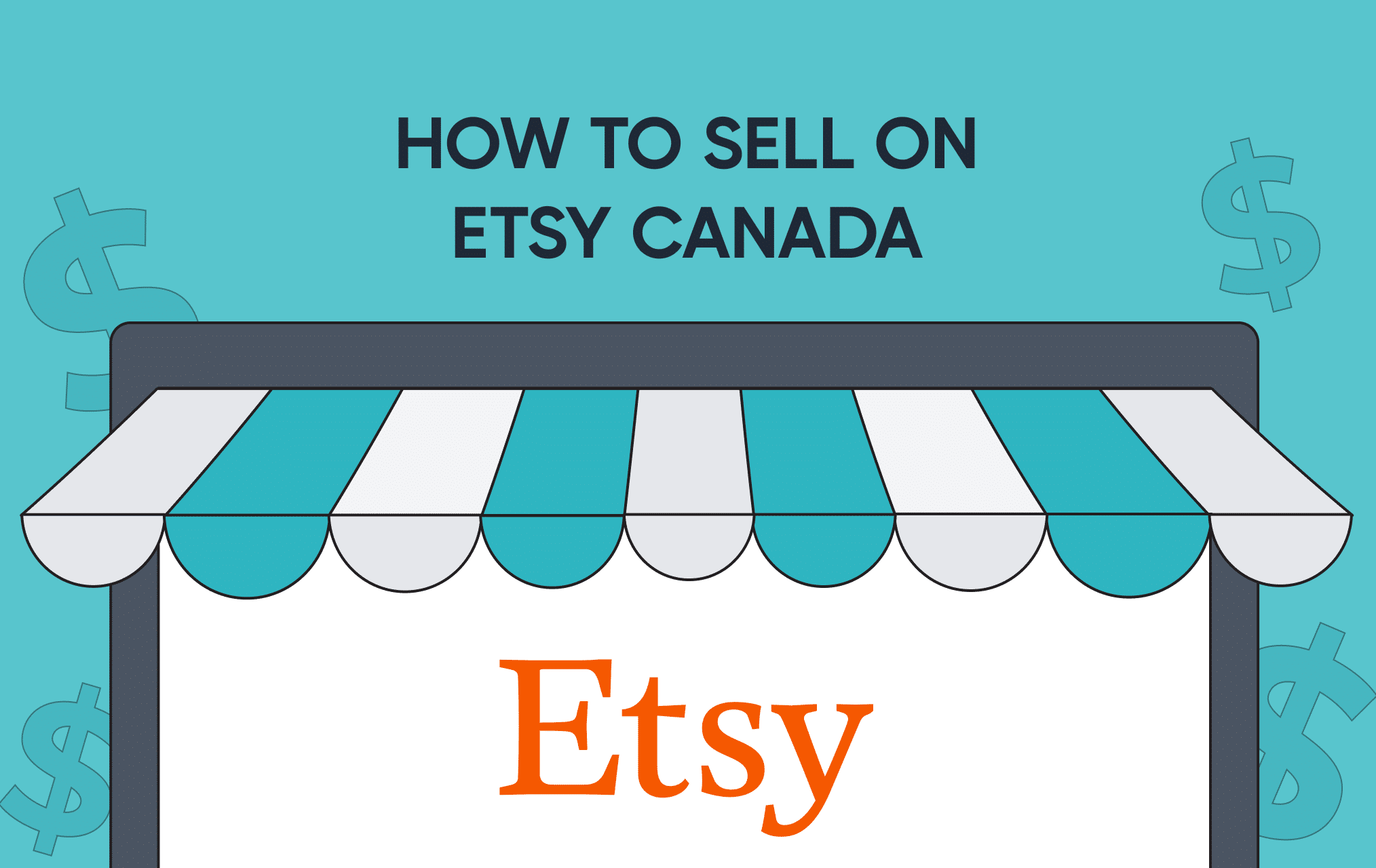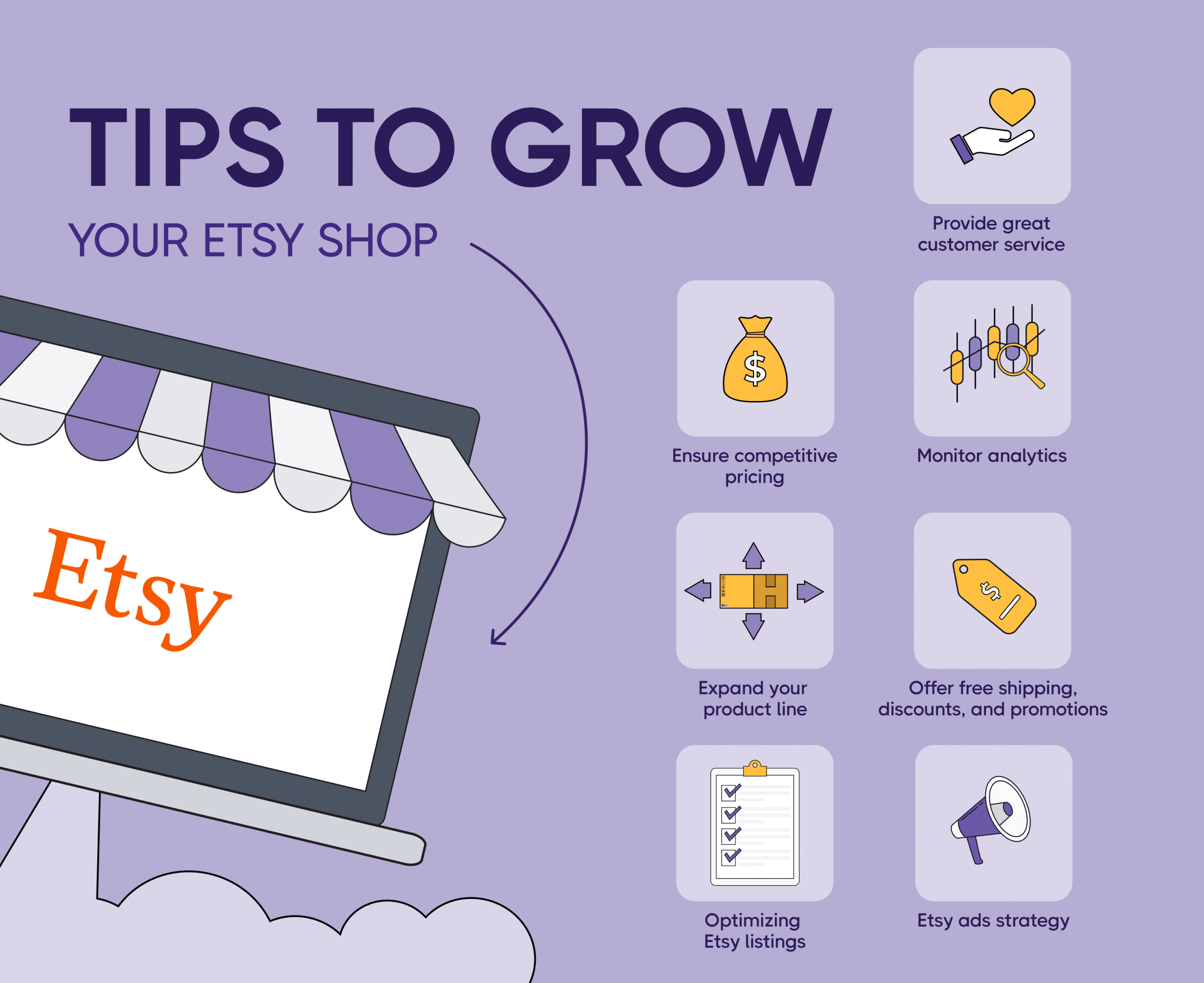
As the holiday season approaches, eCommerce businesses across Canada are gearing up for what is…
MIKAEEL DEWJI
8 mins read
18 mins read

Sarah Kermalli
June 27, 2024
If you've ever dreamed of turning your creative passion into a profitable business, selling on Etsy might be the perfect opportunity. With the rise of eCommerce, many people are flocking to Etsy, one of the best platforms for finding and selling handmade goods, which continues to grow year after year. With over 7.4 million active sellers globally as of 2022, Etsy is a notable success story. In this blog, we’ll cover the basics of getting started on Etsy, from setting up and growing your shop to mastering Etsy product descriptions.
With $13.5 billion in gross merchandise sales in 2021, this platform has demonstrated how much consumer demand there is for unique, artisan products including sentimental antique treasures.
Etsy's appeal is growing in Canada, and Canadian sellers are largely responsible for this expansion.
The platform offers numerous advantages for small business owners and creative entrepreneurs. Let’s take a look at these benefits:
With a good plan and some hard work, selling on Etsy can bring in great profits and be very fulfilling.
Setting up your Etsy shop is straightforward, but doing it right can set the stage for success.
Here are the steps for your Etsy shop setup:
Begin by creating an Etsy account. Once you’ve signed up, click on “Sell on Etsy” and follow the prompts to set up your shop preferences, including your shop language, country, and currency.
Your shop name and branding are crucial. Choose a name that reflects your products and is easy to remember. Create a logo that tells the story of your brand and make sure it ties together all elements in your shop seamlessly. When your brand message is always the same, shoppers can spot it quickly and will come to rely on it more.
Create detailed product listings (we’ll go into more detail about this later) with high-quality photos, potentially enhanced using an AI image upscaler.
Write clear, concise, and compelling product descriptions. Mention materials used, dimensions, and any special features. Pricing should reflect the value of your products while remaining competitive.
SEO (Search Engine Optimization) is essential for getting your products noticed on Etsy. SEO helps your products appear in search results when potential customers are looking for items like yours.
Boosting your listings can really help you get noticed more often. When you look for something on Etsy, the site decides which products to show you by considering several things like how relevant the item is, how good the listing looks, and what past customers thought of their experience.
Boosting your shop's visibility and drawing in more buyers becomes much easier when you get the hang of SEO best practices. Here’s how you can get started:
Identify keywords that shoppers use to find products similar to yours. Etsy’s search suggestions, Google Keyword Planner, and other SEO tools are great for discovering the right keywords to use.
Use these keywords in your product titles, tags, and descriptions. Choosing relevant keywords can make it much simpler for people to spot your items in the sea of options available on Etsy.
Incorporate keywords naturally into your product descriptions to improve visibility. Avoid keyword stuffing, as it makes descriptions hard to read and less appealing. Focus on providing engaging and useful information about your products. Consider the following points:
By improving your SEO, you make it easier for customers to find and purchase your products. Provide all necessary details to boost customer confidence in their buying decision.
With a growing number of shoppers using mobile devices, optimizing your listings for mobile is crucial.
Ensure your photos are of high quality and load quickly, and that your descriptions are easy to read on smaller screens. Mobile optimization also involves ensuring that your titles and key information are visible without needing to scroll extensively.
Since mobile users may have less patience for navigating long pages, a clean and user-friendly mobile experience can lead to higher engagement and conversion rates.
Making sure your shipping process runs smoothly can really boost customer happiness and help your store thrive. Here are some essential Etsy shipping tips to keep in mind:
Shipping Basics to Get Started: Calculated Shipping
If you decide to purchase shipping labels through Etsy, the package details from the order are automatically imported into the shipping label purchase page. The steps to set this up include:
Canadian sellers can use calculated shipping if they ship with Canada Post. Calculated shipping means that when a buyer enters their address and chooses a service, Etsy will calculate the shipping and add it to the cost of the order automatically – making it as simple as possible for you!
If you live in another country or don’t want to use calculated shipping, you can add your own shipping rates to your listings too!
Partner with a 3PL: eShipper
Partnering with a third-party logistics provider (3PL) like us here at eShipper can help streamline your shipping process. While you are the expert in your products, we bring the expertise in shipping to help your Etsy store thrive.
We offer discounted rates with most major carriers. Additionally, we have experience with Etsy and can help get your shipping details set up and ready for your customers. This lets you zero in on building up your business without distractions.
With the basics of your shop sorted out, you will want to turn your attention towards scaling up. Here are some tips for growing your Etsy shop:

Research your competitors and price your products competitively. Consider your costs and desired profit margins. Offering bundles or discounts for multiple purchases can also attract more customers.
Regularly update and optimize your listings based on performance data. Use Etsy’s analytics tools to track which listings are performing well and which may need some improvement.
When you advertise with Etsy Ads, your listings stand out, making it easier to reach buyers with a higher intent to purchase.
You can use Etsy Ads to advertise your products across their search results and other pages on Etsy. Choose your budget, which listings to advertise, the customer countries you want to focus on, and they’ll do the rest.
Broadening the types of products available from your business might just catch the eye of more potential clients out there. Add fresh items to your lineup that match what you’re currently selling. This way, you'll see customers returning again and again, excited for another purchase.
You may want to consider seasonal trends and holidays when deciding what new items you will add to your store.
Exceptional customer service is key to building a loyal customer base. Respond to inquiries promptly, address any issues professionally, and exceed customer expectations whenever possible. It makes a huge difference.
Track the performance of your store using the helpful analytics tools provided by Etsy. It's important to track numbers like how many people view your work, favourite it, or buy it.
Leverage this information to refine what you're selling online. Use this data to refine your product offerings, set competitive price points, and develop effective advertising strategies to attract more customers.
Want more buyers? Try adding free shipping as an option. Offering discounts and running promotions can help move older stock off the shelves while giving sales a nice bump. It’s important to switch strategies up at times.
Understanding Etsy’s fee structure and policies is essential for managing your business effectively. Here are some things to keep in mind:
Etsy charges several fees. They include a listing fee for each item you post, transaction fees when your items sell, and payment processing fees to handle the money. Here’s a quick breakdown of the main fees you’ll need to take note of:
The following types of items are prohibited or restricted on Etsy:
Apart from these items, it’s important to keep in mind that Etsy advises against mass-produced or non-handmade items. Their focus is on unique, creative, vintage, and handmade products.
Etsy offers huge potential for creative entrepreneurs or small businesses to start selling and earn profitsprofiting from their unique products.
We hope this blog has armed and empowered you to begin your Etsy selling journey – from crafting your Etsy product descriptions to your Etsy ads strategy.
If you’re looking for some help in this process and getting your shipping strategy setup, reach out to us here at eShipper today and get your store up and running in no time.
To start selling on Etsy, you'll need to create an account and click on "Sell on Etsy." Follow the prompts to set up your shop preferences, including your shop language, country, and currency. After setting up, you can start adding your products and optimizing your listings.
The steps for setting up your Etsy shop include account creation, choosing a memorable shop name, branding your shop, creating detailed product listings with high-quality photos, and writing clear, concise product descriptions. Proper setup is crucial for long-term success.
Some Etsy SEO for beginners tips include:
To optimize your Etsy listings, use high-quality photos, detailed and engaging descriptions, and include relevant keywords. Regularly update your listings based on performance data from Etsy’s analytics tools to improve visibility and sales.
Ensure smooth shipping by setting up a calculated shipping profile, adding size and weight information to your listings, and partnering with a third-party logistics provider like eShipper. This can streamline your shipping process and improve customer satisfaction.
To grow your Etsy shop, ensure competitive pricing, regularly optimize your listings, expand your product line, provide excellent customer service, and monitor analytics. Leveraging promotions and ads can also boost your shop’s visibility and sales.
Effective product descriptions should incorporate relevant keywords naturally, provide detailed information about the materials, dimensions, and special features of the products, and include care instructions and usage ideas. Avoid keyword stuffing to keep descriptions readable and appealing.
Use tools like Etsy’s search suggestions, Google Keyword Planner, and other SEO tools to find the right keywords. Incorporate these keywords into your product titles, tags, and descriptions to help potential buyers find your products easily.
An effective Etsy ads strategy involves setting a budget, selecting which listings to advertise, and targeting customer countries. Etsy Ads can help your listings stand out in search results and other pages, reaching buyers with a higher intent to purchase.
With a growing number of shoppers using mobile devices, Etsy mobile optimization is crucial. Ensure your photos are high quality and load quickly, and that descriptions are easy to read on smaller screens. A clean and user-friendly mobile experience can lead to higher engagement and conversion rates.
Etsy offers a large and engaged user base, a supportive community, minimal upfront costs, and creative freedom. It provides numerous resources to help sellers succeed, from marketing tools to detailed analytics, making it an attractive platform for creative entrepreneurs.
When setting up shipping on Etsy, consider using calculated shipping profiles, adding accurate size and weight information, and partnering with a 3PL like eShipper for discounted rates and streamlined processes. This can enhance the customer experience and help manage shipping costs effectively.